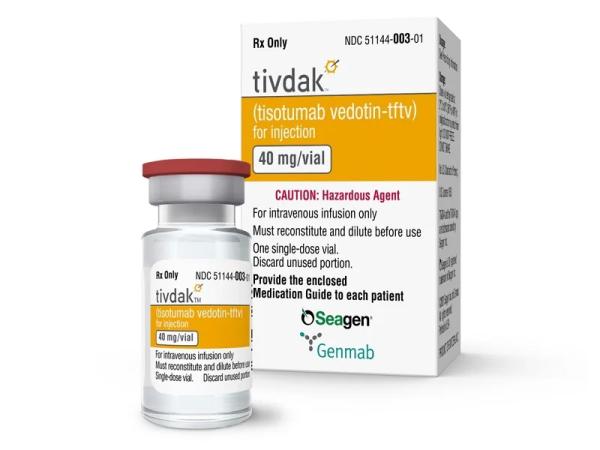Tisotumab Vedotin Dosage
Medically reviewed by Drugs.com. Last updated on Oct 4, 2024.
Applies to the following strengths: tftv 40 mg
Usual Adult Dose for:
Additional dosage information:
Usual Adult Dose for Cervical Cancer
2 mg/kg (up to a maximum of 200 mg for patients 100 kg or greater) IV over 30 minutes every 3 weeks until disease progression or unacceptable toxicity
Premedication and Eye Care:
- Conduct an ophthalmic exam including visual acuity and slit lamp exam at baseline, prior to each dose, and as indicated.
- The initial prescription and all renewals of any corticosteroid medications should be made only after examination with a slit lamp.
- Administer the first drop in each eye prior to each infusion; continue to administer the drops in each eye 72 hours after each infusion.
- Administer topical ocular vasoconstrictor drops in each eye immediately prior to each infusion.
- Use cooling eye pads during the infusion.
- Administer topical lubricating eye drops for the duration of therapy and for 30 days after the last dose.
- Advise patients to avoid wearing contact lenses unless advised by their eye care provider for the entire duration of therapy.
Use: For the treatment of adult patients with recurrent or metastatic cervical cancer with disease progression on or after chemotherapy
Renal Dose Adjustments
Data not available
Liver Dose Adjustments
Mild hepatic impairment: No adjustment recommended.
Moderate or severe hepatic impairment: Not recommended.
Dose Adjustments
DOSE MODIFICATIONS FOR ADVERSE REACTIONS:
- Starting dose: 2 mg/kg
- First dose reduction: 1.3 mg/kg
- Second dose reduction: 0.9 mg/kg
DOSE MODIFICATIONS FOR ADVERSE REACTIONS:
KERATITIS:
Superficial Punctate Keratitis (SPK):
- Any: Monitor
- First occurrence: Withhold dose until SPK or normal, then resume therapy at the next lower dose level
- Second occurrence: Permanently discontinue therapy
- Any: Permanently discontinue therapy
Any Ulceration:
- First occurrence: Withhold dose until complete conjunctival re-epithelialization, then resume therapy at the next lower dose level
- Second occurrence: Permanently discontinue therapy
Any Scarring or Symblepharon:
- Any: Permanently discontinue therapy
Grade 1:
- Any: Monitor
- First occurrence: Withhold dose until Grade 1 or less then resume at the same dose
- Second occurrence: Withhold dose until Grade 1 or less then resume at the next lower dose level; if no resolution to Grade 1 or less, permanently discontinue therapy
- Third occurrence: Permanently discontinue therapy
- Any: Permanently discontinue therapy
- Any: Permanently discontinue therapy
Grade 2:
- Any (initial or worsening of pre-existing condition): Withhold dose until Grade 1 or less, then resume at the next lower dose
- Any: Permanently discontinue therapy
Any Grade Pulmonary or Central Nervous System (CNS):
- Any: Permanently discontinue therapy
- Any: Withhold therapy until resolved then resume at the same dose
- First occurrence: Withhold dose until resolved then resume at the same dose
- Second occurrence: Permanently discontinue therapy
- Any: Permanently discontinue therapy
Grade 2:
- Any: Withhold dose until Grade 1 or less for persistent or recurrent pneumonitis; consider resuming therapy at next lower dose level
- Any: Permanently discontinue therapy
Precautions
US BOXED WARNINGS:
OCULAR TOXICITY:
- This drug causes changes in the corneal epithelium and conjunctiva resulting in changes in vision, including severe vision loss, and corneal ulceration.
- Perform an ophthalmic exam at baseline, prior to each dose, and as indicated.
- Adhere to premedication and required eye care before, during, and after infusion.
- Withhold therapy until improvement and resume, reduce the dose, or permanently discontinue, based on severity.
CONTRAINDICATIONS: None
Safety and efficacy have not been established in patients younger than 18 years.
Consult WARNINGS section for additional precautions.
Dialysis
Data not available
Other Comments
Administration advice:
- This drug is available for IV administration; do not administer as IV push or bolus.
Storage requirements:
- Store vial refrigerated at 2C to 8C (36F to 46F) in the original carton to protect from light; do not freeze; do not shake.
Reconstitution/preparation techniques:
- Use aseptic technique for reconstitution and preparation of this drug.
- The manufacturer product information should be consulted.
IV compatibility:
- Dextrose 5% Injection
- Sodium Chloride 0.9% Injection
- Lactated Ringer's Injection
Monitoring:
- Renal
- Hepatic
Patient advice:
- This drug can harm a developing baby.
- Proper ocular care is essential when receiving this drug.
More about tisotumab vedotin
- Check interactions
- Compare alternatives
- Side effects
- During pregnancy
- Drug class: miscellaneous antineoplastics
- Breastfeeding
- En español
Patient resources
Other brands
Professional resources
Other brands
Related treatment guides
See also:
Further information
Always consult your healthcare provider to ensure the information displayed on this page applies to your personal circumstances.


